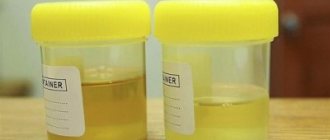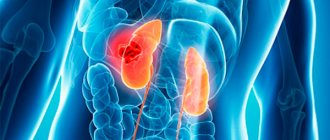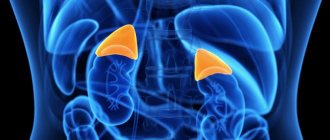Mechanism of urination
Urine is the finished product of metabolic activities in the body. It contains toxins that are excreted through urination. The mechanism of urine formation goes through 3 stages:
- Formation of primary biological fluid. Due to the process of renal filtration, water and harmful substances from the blood enter the kidney tubules.
- Reabsorption. There is incomplete reabsorption of liquid and concentrated substances into the systemic circulation.
- Secretion. Through the renal sections, the resulting fluid moves to the ureter and penetrates the urinary organ. Accumulating there, it irritates the membrane, causing an impulse to be sent to the brain about the need to urinate.
The appearance of hot urine in an adult or child indicates disturbances in the urinary mechanism. Decreased immunity activates pathogens in the urinary tract or excretory system. The activity of pathogenic microflora disrupts the normal procedure for emptying the bladder and causes a feeling of hot urine during urination.
What should the urine of a healthy person look like?
The most important function of the human body is the elimination of fluid (urination). The color and smell of urine excreted make it possible to identify malfunctions in the body and identify various diseases.
It is impossible to give a definite answer to the question of what color urine should be in a healthy person. This is due to the fact that there are many different factors that can affect the color of urine excreted:
- the lifestyle a person leads;
- climatic living conditions;
- nutrition;
- amount of fluid consumed over 24 hours;
- presence of chronic diseases;
- degree of physical activity;
- metabolic disorders.
It should be emphasized that most of the factors influencing changes in the color of urine, as a rule, are not a symptom of pathologies occurring in the body.
It is worth noting that according to generally accepted standards, the natural color of urine is straw-yellow. This is due to the amount of bile pigments that are in it. However, due to the influence of the above factors, it may vary slightly. In addition, the shade of urine can be individual for each person due to the characteristics of the body.
Straw-yellow urine is normal
In adults, urine has a more saturated color than in childhood.
Urine color index
When conducting a general urine test, specialists also take into account the color indicator. Based on color, the doctor can analyze the content of various minerals, as well as other substances in the urine. For the purpose of prevention, experts recommend taking a general urine test 2 times a year, thereby promptly identifying emerging problems in the human body.
Please note that the color of urine in adults is the most saturated, which cannot be said about children. The normal color is straw, which is provided by the presence of urobilin, uroerythrin, urochrome, and other pigments. If a person often experiences clear urine, the reason may lie in the disappearance of these coloring substances. Since pigments are formed from trace elements and salts, there is a metabolic disorder in the body.
Among the components of the form for general urine analysis is a color indicator. By color, a specialist can analyze the content of various minerals and other substances in urine.
It is recommended to perform a general analysis twice a year to ensure that any problems that arise are identified and corrected in a timely manner.
Urine in adults is more saturated in color than in children. The normal color of urine is straw yellow, which is achieved due to the presence of urobilin, urochrome, uroerythrin and a number of other pigments. If a person regularly has colorless urine, this means that the indicated coloring substances have disappeared from it. Since pigments are formed from salts and microelements, metabolic processes in the body may be disrupted.
It turns out that loss of color in urine is a common occurrence for a healthy person. It is associated with excess fluid consumption, which happens with severe thirst, in hot weather, and during intense physical activity. At the same time, the bladder quickly fills with liquid, so the urine simply does not have time to color. However, the urine will still have a slight tint of yellow, which is noticeable if you urinate in an opaque white container.
The reasons for the appearance of faintly colored urine may be different. If the condition is not systemic, but appears periodically, you need to look for prerequisites in:
- abuse of diuretics - tablets, teas with diuretic herbs;
- drinking large amounts of black, green tea, coffee;
- increased physical activity, hard work;
- suffered stress;
- severe hypothermia of the body;
- drinking alcoholic beverages.
For those who take drugs with phosphorus and calcium, the urine may also become somewhat lighter. After analyzing possible harmless causes, you can easily find those that provoked the appearance of clear urine. But in some cases, medical help cannot be avoided, because a change in the color of urine can signal the development of disease.
Normal urine temperature is 37 degrees.
During normal excretion, urine is no higher than the temperature of the human body. In the absence of pathological abnormalities in the urinary and reproductive system, its temperature is 37 °C. Thermometer readings below this mark are also considered normal. Since the normal temperature for an adult is 36.6 °C, when urinating, the urine will feel warm or hot.
Causes of clear urine in women
With high fluid intake and, accordingly, frequent urination, urine discoloration may occur, which is the absolute norm. At the same time, the bladder fills very quickly, so the urine simply does not have time to color.
The color of urine in most cases depends on the amount of fluid a person takes during the day.
If clear urine appears from time to time, then its cause may lie in the influence of the following factors:
- abuse of diuretics or drinks (tea, coffee);
- drinking alcohol;
- active physical activity;
- emotional overload;
- hypothermia.
Many of these factors can be corrected independently, and the color of urine will become normal.
https://www.youtube.com/watch?v=hENrXNmUQtQ
Alcohol and caffeine inhibit the body's ability to absorb water in the kidneys. It is quickly removed without having time to be colored with pigments. Together with it, the body leaves the minerals and electrolytes we need. This can lead to serious health consequences.
There are many reasons why urine is colorless, and they differ in men and women.
In the fair sex, the color of urine may change during pregnancy, as hormonal changes occur. The disorder may be accompanied by toxicosis, since the body is dehydrated and the expectant mother drinks large amounts of water. If you change your drinking regime, the color of your urine should become light yellow.
Red urine in pregnant women can be observed after a woman eats blackberries, pomegranates or beets.
Dark yellow urine appears in rare cases in the last trimester and may be accompanied by swelling and dehydration.
According to statistics, many women suffer from diabetes, so if you have a frequent desire to drink water, you need to consult a doctor and undergo an examination.
In female representatives, urine becomes discolored for a number of reasons:
- diabetes mellitus, in which the urine acquires a specific sweetish odor;
- renal failure is a severe pathology in which the kidneys lose their ability to cleanse the blood, as a result the body becomes polluted;
- pregnancy and associated hormonal changes.
During pregnancy, urine becomes discolored more often during toxicosis, when the female body becomes dehydrated. As a result, the woman drinks a lot, and as a result, the urine loses color due to a lack of pigments.
Transparent, almost water-like urine in a newborn and infant is a common occurrence and is not a cause for concern.
The reason is simple: the kidneys of a child under one year of age have not fully formed, and pigment saturation is weak. Another child at the age of 6-7 months eats only breast milk or formula, so the concentration of urine is low. In addition, children's urine has virtually no specific odor.
After expanding the diet (after 7-8 months), the concentration of urine begins to increase, and a light straw tint appears. After 1.5-2 years, children's urine acquires a yellow-straw hue, becoming similar to the urine of adults.
https://www.youtube.com/watch?v=https:_KLwEPmSbAk
If a child who is 8-10 months old has no color in their urine, you should contact your pediatrician to rule out problems such as:
- pyelonephritis;
- congenital developmental anomalies;
- metabolic disorders.
In children of primary school age and adolescence, discolored urine can signal the development of:
- endocrine disorders;
- diabetes mellitus;
- urolithiasis.
In adolescents, urine may lose color due to hormonal changes during puberty. Normally, this happens periodically, but not more often than 3-5 days in a row.
To regularly monitor the adequate functioning of the urinary system in children, it is necessary to take a general urine test every 6 months.
Separately, it is worth considering the ailments of the fair half of humanity. The main factor influencing the color of urine is the levels of hormones in a woman’s body. Various hormonal abnormalities provoke changes in the metabolic process, as well as other disorders. If the urine becomes clear, like water, then the woman should immediately contact an endocrinologist and undergo diagnostics of the pancreas, adrenal glands, and thyroid gland. This is especially important if additional symptoms of diabetes mellitus and dysfunction of hormone-producing organs are observed.
What else can be said about the causes of clear urine? Often the color of urine changes in women during pregnancy. Transparency is most often explained by toxicosis in the early stages, since a woman begins to drink large amounts of water during this period. During toxicosis, urine may also acquire an unpleasant aroma, but only a doctor should make an accurate diagnosis.
A woman should be wary if she observes almost clear urine. The reason may lie in the development of a gynecological disease. If the color has become too light and there is white discharge in the liquid, this indicates an inflammatory process in the walls of the vagina, as well as the cervix. Also in this case, a large amount of exudate is released.
Alexander Myasnikov in the program “About the Most Important Thing” talks about how to treat KIDNEY DISEASES and what to take.
Urine, or urine, is an important biological fluid of the body, because it removes waste, toxins and other unnecessary metabolites. The familiar yellow color of urine is a consequence of the presence of a special pigment in it. But sometimes a person experiences clear urine. This usually happens in hot weather when fluid consumption increases.
Urolithiasis disease
Urination may be accompanied by a burning sensation in case of acute urolithiasis. A similar pathological process is characterized by stone formation in the urinary system. Pathology develops as a result of metabolic disorders and under the influence of changes in the structure of the blood.
We suggest you read: Delayed menstruation after stopping birth control pills
An attack of exacerbation is accompanied by severe pain in the lumbar area. When the patient moves, the pain only intensifies. The pain syndrome radiates to various parts of the body:
- To the genitals;
- Underbelly;
- Rectum, etc.
Along with the pain, the man notes a frequent desire to run to the toilet, and a burning sensation occurs when urinating. Urine often has a reddish tint, because as stones move through the urinary tract, they injure their walls.
Treatment tactics can be based on a conservative and surgical approach. Sometimes medications are prescribed to dissolve stones, and if the stone blocks the passage and interferes with urinary outflow, it is removed surgically. Nutrition is also important, requiring the patient to strictly adhere to a specialized diet, the principles of which depend on the chemical basis of the stones.
Clear (colorless) urine in adults and children
A child's kidneys are different from those of an adult. The baby's urine after birth and for several years has a low concentration, since he receives only mother's milk. As the child grows and develops, the color of the urine becomes light yellow; clear urine can be observed in those who drink large amounts of liquid.
When sperm gets into the urine, the latter may take on a white tint, but this condition in men goes away in a matter of hours and is not a pathology. Intensive water consumption during physical activity, sports training, or work often causes urine to become lighter, and there is no need to worry about this.
In men, increased fluid intake may be associated with hypertension and obesity. If a person was not in a hot room and did not work physically, it is worth measuring the pressure level - perhaps it will be elevated. Thirst and excessive discharge of clear urine in men can serve as a symptom of diabetes mellitus. If you suspect this disease, you should take a blood test for glucose as early as possible.
It is normal for a child to have colorless urine in the first months of life. Kidneys work differently in babies, and the concentration of pigments in the urine will be very low. Only when food other than breast milk is added to the baby’s diet does the urine gradually begin to darken. Only by the age of 1.5-2 years, the urine in children becomes close in color to the urine of an adult, acquiring a straw-yellow color.
If a child of 8-10 months, whose menu contains a sufficient amount of regular foods, has urine that remains clear, a diagnosis should be made to rule out:
- congenital diabetes mellitus;
- other metabolic disorders;
- pyelonephritis;
- anomalies in the structure of internal organs.
In school-age children, the cause of this problem is often chronic kidney disease and diabetes. In adolescents during hormonal fluctuations, the appearance of clear urine is normal if it lasts no longer than 3-5 days in a row.
| Illness | Cause |
| Urethritis | Inflammatory process occurring in the urinary tract |
| Cystitis | Inflammation of the bladder walls |
| Venereal diseases | Pathologies in the genitourinary system |
| Prostatitis | Compression of the excretory canal, difficulty in the outflow of urine due to swelling of the prostate gland |
| ARVI, flu | General increase in body temperature |
| Poisoning of the body | Irritation of the mucous membrane of the urinary canal by poisonous, toxic substances |
In women, warmer urine may be a sign of cystitis.
As a result of such diseases, urine becomes several degrees hotter than normal. But the burning sensation that accompanies them really feels like very hot urine. The sign of warm urine in women corresponds to the development of cystitis, and in men - urethritis. In a child, an increase in urine temperature is a sign of the spread of a bacterial, fungal or viral infection in the body.
If the urethra is inflamed
Often, a burning sensation during urination appears due to inflammation that occurs on the walls of the urethra (urethritis). This pathology usually develops due to the penetration of various pathogenic microorganisms such as mycoplasma, chlamydia or trichomonas, staphylococcal agent, etc. into the urethra.
- Itching sensation on the head of the penis and inside it;
- Inflammatory manifestations on the flesh and head;
- Painful bowel movements;
- Urinary disorders;
- Discharge of mucous or purulent origin, sometimes with bloody patches.
The danger of untreated urethritis lies in the further spread of inflammation along an ascending principle from the urethra to the scrotum, testicles, appendages, prostate, etc. The basis of therapy is immunostimulating and antibiotic therapy, the introduction of antiseptic and anti-inflammatory solutions into the urethra. Early treatment guarantees quick and final relief from the unpleasant pathology.
Clear urine is a sign of pathology
Sometimes a change in the shade of urine indicates the appearance of pathology or inflammation of the urinary system:
- pyelonephritis - inflammation of the renal pyelocaliceal system;
- chronic renal failure - irreversible impairment of kidney function;
- urolithiasis - the formation of stones in the kidneys or bladder;
- neoplasms in the kidneys.
If the urine is clear in the morning, and during the day the volume of urine excreted is increased (a person often urinates a lot), this may be a symptom of diabetes mellitus, a disease caused by metabolic disorders. In this case, other signs of pathology will appear:
- urine acquires a sweetish odor;
- urine may be completely discolored (like water) and smell like acetone (this symptom is observed in severe cases of the disease).
Clear urine can also be a symptom of liver problems. The fact is that urine is colored yellow by pigments produced by this organ. Therefore, if pigments are not produced, then the cause may be a violation of its functions:
- hepatitis is an inflammatory disease of the liver;
- cirrhosis - irreversible replacement of functional cells of an organ with connective tissue;
Liver cirrhosis is a chronic disease with progressive liver damage and complete restructuring of its tissue, resulting in severe impairment of all organ functions and chronic liver failure. - fatty hepatosis is the accumulation of fat in liver cells, which disrupts its functioning.
Of course, the color of urine will not be the only sign of pathology. May also appear:
- yellowing of the skin and mucous membranes;
- digestive disorders (diarrhea and constipation);
- nausea;
- bitter taste in the mouth.
These same symptoms, including clear and discolored urine, can cause gallbladder disease, especially:
- formation of stones in it;
- blockage of the duct by a neoplasm (polyp, tumor).
All these pathologies cause an insufficient supply of coloring pigments in the urine, which is why it turns the color of water. Therefore, if urine discoloration is observed regularly, you should not delay a visit to the doctor.
In women, the appearance of colorless urine may indicate the presence of a pathology such as renal failure. However, this same symptom may indicate pregnancy. It acquires this shade in pregnant women due to a significant change in hormone levels. In addition, when toxicosis occurs, a woman increases her fluid intake, which also affects the color of the urine.
If pregnancy is not confirmed, then a hormone imbalance can cause urine discoloration. In this case, its cause should be sought in collaboration with doctors: a gynecologist and an endocrinologist. Diseases of the reproductive system, in particular, inflammatory processes of the walls of the vagina and cervix, can also play a certain role.
Also, one should not exclude the development of diabetes mellitus, which also requires careful diagnosis.
When should you see a doctor?
If hot urine is the only symptom, and no other unusual sensations occur when urinating, then you can postpone a visit to the hospital.
Emergency medical attention should be sought for the following accompanying symptoms:
- very high body temperature;
- back pain, which may indicate a kidney infection;
- uncontrollable vomiting.
You should see your doctor within one to two days if you experience the following:
- painful urination;
- unpleasant odor of urine;
- frequent urination.
Clear urine: causes, possible diseases and treatment
If a patient has a violation of water-salt metabolism, which is characterized by excess water, it is necessary to adjust the drinking regime and change the diet.
It must be balanced. It is necessary to eat lean meat, fish, legumes, grains, vegetables, eggs, walnuts and seeds.
Special drinks that can be prepared at home will help restore hydration in both men and women. One common one is lemon remedy. To prepare it, take 2 liters of purified water, add 100 ml of lemon juice and ½ tsp. sea salt and 1 tbsp. l. honey
The next healthy drink that will return a healthy color to urine and restore water-salt metabolism is coconut juice in combination with sea salt. You need to take 400 ml of juice, add ½ tsp to it. sea salt and the same amount of honey, pour 1 liter of water.
A homemade drink based on lime and lemon has proven itself well. You need to take 1 liter of water, then add lemon, orange and lime juice in equal proportions, you will also need 1 tsp. sea salt.
All drinks are able to compensate for the electrolytes lost by the body.
People who lead a sedentary lifestyle, often eat spicy and meat dishes, regularly drink alcoholic beverages and smoke are prone to disturbances in water-salt metabolism. A disorder manifests itself in the form of joint pathology, the color of urine changes, crunching and pain appear in the extremities, spurs form, etc. Patients have a tendency to swelling, surges in blood pressure, and changes in the acid-base balance.
If a person drinks large quantities of water, he may develop water intoxication. In this case, complications may include hyponatremia or hypokalemia. Symptoms of these pathologies include vomiting, white urine, general weakness of the body, and in rare cases, convulsions. In the worst case, at the most severe stage, a specialist can diagnose pulmonary edema or ascites.
To replenish potassium reserves in the body, you need to introduce foods such as dried apricots, raisins, prunes into your diet, and drink freshly squeezed apricot, peach or cherry juice. Sometimes a specialist can prescribe medications that contain potassium, for example, asparkam.
Hyponatremia is typical for patients with acute alcoholic hepatitis. It is also observed in people with kidney pathology, liver cirrhosis, etc. Symptoms of this disease are:
- fast fatiguability;
- headache and dizziness;
- irritability;
- diarrhea.
Treatment usually consists of intravenous injections of saline solution.
For hypercalcemia, the doctor prescribes diuretic drugs. These include furosemide and potassium chloride. In some cases, it is necessary to take salmon calcitonin.
If a person discovers that the urine has become transparent, it is necessary to adjust the volume of fluid consumed (water, tea, juice) to 1-1.5 liters per day. In the absence of pathological processes, the problem will go away within a week.
If this does not happen, you need qualified help.
Seeing a urologist is the best option. Through a full examination, the problem will be identified in a couple of weeks. The doctor will prescribe treatment based on the diagnosis. For diseases of the kidneys and urinary tract, antibacterial drugs will be prescribed, for endocrine pathologies - maintenance therapy or hormones.
Colorless urine does not always indicate the presence of serious pathologies; sometimes this phenomenon is within the normal range. But you shouldn’t put off a timely visit to a urologist or nephrologist - it’s easier to identify the cause of the problem earlier and successfully eliminate it.
And to prevent possible illnesses with the urinary system, you should take a urine test at least once a year.
Urine is an important biological fluid in the human body, as it removes waste, toxins, and other harmful metabolites from it. For everyone, the familiar yellow shade is characterized by the presence of a certain pigment. In some cases, it is for this reason that a person’s urine is clear.
That is, there is too little pigment in the urine, its concentration is insufficient for coloring. As a rule, this symptom is observed in the hot season, when fluid intake increases. There is no need to worry in such a situation. But if you have clear urine for another reason, and this change bothers you constantly, then you should consult a specialist.
If the cause of clear urine does not relate to a pathological condition, then you only need to normalize your drinking regime. Adults, in the absence of any problems with the kidneys or heart, should drink about 2 liters of plain clean water per day. If a person is in a hot and too stuffy room, and also has increased intense loads, then the need for water consumption increases.
It is also necessary to avoid smoked, salty, hot, spicy, fried foods, which contribute to fluid retention, as well as disruption of the water-salt balance in the body. In case of a forced increase in the amount of fluid, mineral water should be consumed to prevent the leaching of minerals from the human body.
In other situations, the color of urine can be normalized only with the help of a doctor by eliminating the cause of the disease.
In parallel with the use of drug therapy, experts recommend performing therapeutic exercises. The fact is that sufficient physical activity stimulates metabolic processes in the human body, while improving the functioning of internal organs and systems.
It would be useful to use physiotherapeutic procedures. Most often, plasmapheresis, ozone therapy, electrophoresis, and other techniques are prescribed for these purposes.
If the urine has become clear due to renal failure, then experts recommend hemodialysis to patients.
For effective treatment of the disease, the main thing is to determine why the urine is hot. The choice of treatment therapy depends entirely on the underlying cause of the disorder. For abnormalities in the genitourinary system, the following are used:
- antibiotics;
- anti-inflammatory drugs;
- antifungal agents.
Folk remedies are used as an adjuvant in the treatment of pathological manifestations. Taking herbal teas, herbal decoctions and infusions has an effective diuretic and anti-inflammatory effect. Wash mixtures made from infusions of wormwood, calendula, fennel, chamomile, and motherwort quickly eliminate inflammation and discomfort.
If there are disturbances in the functioning of the urinary organs, it is possible for toxins to penetrate from the urine into the bloodstream and internal organs, which poses a threat to human life. Therefore, if you feel hot urine, you should urgently visit a urologist and determine why such a pathological symptom appeared.
It's all due to prostatitis
Prostatitis is a fairly widespread disease among men (women are not affected by this disease, since the prostate gland is an organ exclusively of the male genitourinary system). Only one out of five representatives of the stronger sex never encounters such a problem in their lives.
Prostatitis is a disease of the male genitourinary system, the obligatory attribute of which is an inflammatory process localized in the prostate gland.
Prostatitis today is so widespread that with almost one hundred percent certainty every man who has crossed the threshold of 45 years can be considered sick to one degree or another.
Why do problems with men's health become more active at this age?
In fact, it all starts much earlier, the modern rhythm of life, oversaturated with stress, an inactive lifestyle, working in an office in front of a computer, poor nutrition, systematic alcohol consumption and sexual intercourse with frequently changing partners without the use of contraception - all these are the very factors , the presence of which gradually leads to inflammation of the prostate.
The symptoms of prostatitis that a man first notices are usually the following:
- At the beginning of the disease, when the prostate has just begun to increase in volume, it only slightly squeezes the ureter, which surrounds it like a ring on a finger. Thus, one of the first symptoms of prostatitis will be considered a slight narrowing of the ureter, and, consequently, some obstruction of the passage of urine - difficulty urinating.
- The resulting problem is frequent urination. At first, this manifestation does not cause concern; a man who has never woken up at night before may get up to empty his bladder once or twice at night and chalk it up to an extra cup of tea at dinner. But, over time, the intervals between the urge to urinate will be significantly reduced.
- The presence of pain in the lower abdomen is also one of the first symptoms of prostatitis. They can have different sensations: pulling, pressing, bursting, they usually bother you at the end of the day or after any strength loads.
- Minor erectile dysfunction and premature ejaculation, of course, cause both the man and his partner some anxiety, but this is also often attributed to fatigue and stress.
We suggest you read: Vitamins when planning pregnancy for men before conception: list, names of multivitamin complexes
Such, seemingly insignificant, disorders of the male genitourinary system, without proper attention, both from the patient and the doctor, will certainly result in big problems, whose name is chronic prostatitis.
Inflammation of the prostate gland can occur either in an acute, bacterial form, or, in the case of an advanced disease, in its complicated, chronic form.
Symptoms of prostatitis in the acute phase of the bacterial form:
- High body temperature, staying around 39 degrees for a long time.
- Chills.
- General weakness, body aches, painful condition.
- Headache.
- Nausea, in particularly difficult cases, leading to frequent vomiting.
- Severe pain in the perineum, lower abdomen, and also periodically in the lower back and testicles. Often the pain intensifies at the time of bowel movement, and mucous discharge from the urethra may also appear during defecation.
- During a rectal digital examination, the doctor may detect an increase in the volume of the prostate gland, a change in its structure - various formations and scars are often palpable.
- Frequent, difficult, painful urination. Due to the fact that the inflamed prostate pinches the urethra too much, a man has to strain to start urinating; for the same reason, in some cases the bladder does not empty completely, which does not bring proper relief after visiting the toilet.
- Sharp pain during ejaculation.
If prostatitis is not treated at this stage, it is guaranteed to develop into a chronic stage.
Often, a burning sensation occurs due to inflammation of the prostate gland, in other words, prostatitis. Such a pathology can develop against the background of repeated hypothermia, lack of regularity in sexual life, genitourinary infections, colds, physical inactivity, etc.
- Increased urination;
- Painful feeling in the rectum, perineum, groin and testicles, penis;
- Erectile disorders;
- Presence of blood in the urine;
- Painful pulling sensation in the lower abdomen;
- Intermittent stream when urinating.
If, when such symptoms occur, a man does not rush to see a urologist and does not receive proper treatment, then the pathological process is complicated by various associated disorders.
Treatment of prostatitis is based on antibiotic therapy, physiotherapy, prostate massage and immunostimulating therapy.
Prevention
To minimize the possibility of diseases that can cause changes in the color of urine, you need to:
- carefully observe personal hygiene;
- watch your diet;
- adhere to a healthy lifestyle;
- treat infectious diseases in a timely manner;
- undergo preventive medical examinations in a timely manner;
- minimize the impact of stress;
- protect yourself from hypothermia.
The presence of light-colored urine in a person is not always a sign of the presence of any serious diseases. In some cases, urine may change color due to excessive or insufficient fluid intake. However, if, against the background of a change in the color of urine, a person also develops secondary symptoms (a change in the smell of urine, the presence of foam or sediment in it, an increase in temperature), then in this case it is recommended to consult a doctor.
It is important to regularly carry out comprehensive diagnostics for the purpose of prevention, especially if diseases of the kidneys, liver, and endocrine system were previously diagnosed. You should also reduce the impact of stress, avoid hypothermia, observe personal hygiene rules, and eat right. All this will lead to a reduction in the likelihood of developing various pathologies of internal organs.
Urine color indicator
Colorless urine is accompanied by a frequent urge to pass urine. It does not linger in the bladder and does not have time to become saturated with the coloring pigment. Quite often, clear urine is observed in those who abuse coffee and tea, since these drinks have diuretic properties.
If a person has colorless urine and a sweet smell, then this is a clear sign that he has diabetes. It is necessary to drink less liquid for 2 weeks, then check the color of the urine; if the urine is clear, like water, then you should consult a doctor and get tested. If women experience a sweet odor when urinating, this may not only indicate the presence of diabetes, but this also happens during pregnancy.
When a patient's urine is brown, it is, on the contrary, a symptom of dehydration, causing the kidneys to produce concentrated urine. The doctor refers the patient for an ultrasound examination, based on the results of which he prescribes appropriate treatment.
The bright yellow color of urine indicates an excess of B vitamins and carotene, which give urine its color.
Quite often, people experience blood when urinating. They can be symptoms of benign tumors, urinary tract infections, injuries after heavy physical activity, and urolithiasis.
Red or pink urine may appear after eating red vegetables and fruits. In rare cases, this phenomenon can occur with mercury or lead poisoning.
Urine turns green after eating asparagus or certain types of drinks and sweets that contain artificial colors.
Sometimes a person may notice blue urine. It is a sign of a genetic pathology called “familial hypercalcemia.” With this disease, the blood contains calcium in an increased volume.
White urine in men indicates prostate disease. If white clots are observed in the urine in the morning or after intimacy, then there is no need to worry, since the remnants of the ejaculate are eliminated when urinating.
The most harmless reason for the appearance of clear urine is excessive fluid intake during the day. When a person drinks about 2.5-3 liters of water per day, urine quickly passes through the kidneys and bladder, without receiving enough urochromes.
A concomitant sign of excessive fluid intake is a frequent urge to urinate with the release of a large volume of urine.
This is not considered a pathology, but it should be remembered that large amounts of water and other drinks can create increased stress on the kidneys and bladder, leading to the excretion of necessary microelements (calcium, magnesium, iron).
If a person notices that his urine has become colorless, he should limit the consumption of water, tea, and juice for 7-10 days. The urine remains clear, which means the problem is different and a visit to the doctor is necessary.
Discoloration of urine may indicate the presence of diseases:
- kidneys and urinary tract;
- endocrine nature (diabetes mellitus);
- liver (cirrhosis, hepatitis).
Discolored urine in men appears due to excess water entering the body, or due to the development of pathological conditions - diabetes mellitus, urolithiasis, hepatitis.
There is a special reason for the loss of urine color in men - the entry of a small amount of sperm into the urethra and urinary canal.
This condition is not considered dangerous; after 3-4 hours, the urine acquires its normal color. But if this does not happen, you need to look for other reasons by contacting a urologist.
Read our article about why adults have cloudy urine.
Editor
Update date: 10/11/2018, next update date: 10/11/2021
Urine may feel hot for two reasons - either because the temperature of the urine is too high, or because of the burning sensation that sometimes accompanies the process of urination. Both of these signs indicate infectious diseases, so if they appear, you should see a doctor as soon as possible, and especially in situations where there are additional symptoms.
In this article, we will explain what the normal urine temperature should be, and also talk about the causes of unusually hot urine and a burning sensation when urinating in men and women. We'll also discuss when you should see a doctor for these symptoms and list available treatment options.
Diagnosis of pathologies
To determine the composition of urine, the specialist sends the patient for analysis. It consists of assessing the physical and chemical characteristics of the liquid and microscopy of the sediment. It is advisable to get tested 2 times a year to prevent further development of urolithiasis, kidney pathology and other serious disorders.
Common causes of clear urine:
- diabetes;
- hepatitis;
- disturbances in the functioning of the liver;
- advanced stage of kidney pathology;
- urolithiasis disease.
If a person produces colorless urine for a long time (more than 2 weeks), there is cause for concern.
Not only waste products of the body, but also useful salts and minerals can be removed from the body. Colorless urine can signal serious illnesses of the kidneys and bladder, endocrine diseases, and liver problems. Contacting a doctor cannot be ignored.
When seeking medical help with complaints of colorless urine, a person is prescribed an examination in order to accurately diagnose pathologies and the causes of deviations from the norm. The list of mandatory tests and examination procedures includes:
- general examination and conversation about complaints;
- general urine analysis;
- microscopic analysis of urine sediment;
- general blood test (in order to establish the general condition, the presence of hidden inflammatory processes);
- biochemical blood test, with mandatory testing of sugar levels;
- Ultrasound of the kidneys, liver, bladder and urinary tract.
https://www.youtube.com/watch?v=eGTWz55j1xY
Based on the examination, the doctor analyzes the results and determines the cause of the illness - a disease, a metabolic disorder, or a temporary malfunction of the body.










